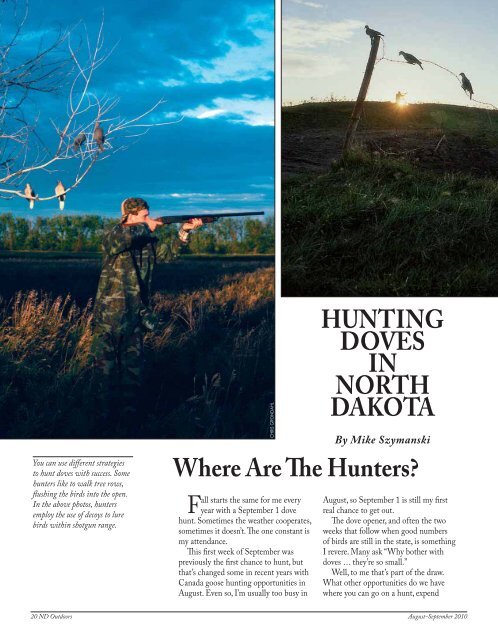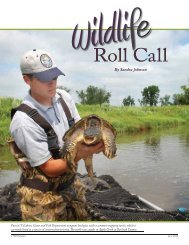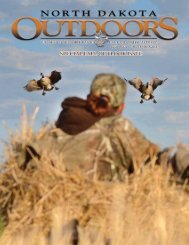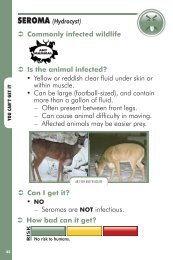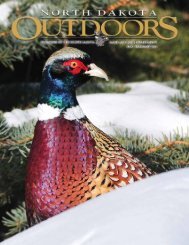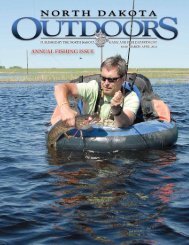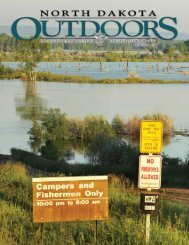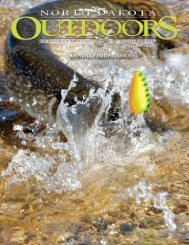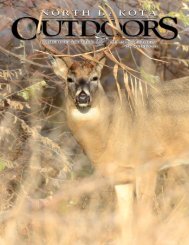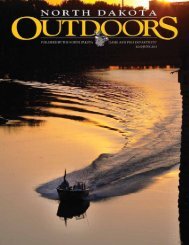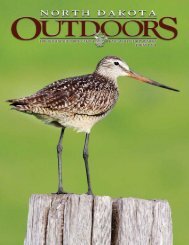HUNTING DOVES IN NORTH DAKOTA - North Dakota Game and Fish
HUNTING DOVES IN NORTH DAKOTA - North Dakota Game and Fish
HUNTING DOVES IN NORTH DAKOTA - North Dakota Game and Fish
Create successful ePaper yourself
Turn your PDF publications into a flip-book with our unique Google optimized e-Paper software.
You can use different strategies<br />
to hunt doves with success. Some<br />
hunters like to walk tree rows,<br />
flushing the birds into the open.<br />
In the above photos, hunters<br />
employ the use of decoys to lure<br />
birds within shotgun range.<br />
Where Are The Hunters?<br />
Fall starts the same for me every<br />
year with a September 1 dove<br />
hunt. Sometimes the weather cooperates,<br />
sometimes it doesn’t. The one constant is<br />
my attendance.<br />
This first week of September was<br />
previously the first chance to hunt, but<br />
that’s changed some in recent years with<br />
Canada goose hunting opportunities in<br />
August. Even so, I’m usually too busy in<br />
CHRIS GRONDAHL<br />
<strong>HUNT<strong>IN</strong>G</strong><br />
<strong>DOVES</strong><br />
<strong>IN</strong><br />
<strong>NORTH</strong><br />
<strong>DAKOTA</strong><br />
By Mike Szymanski<br />
August, so September 1 is still my first<br />
real chance to get out.<br />
The dove opener, <strong>and</strong> often the two<br />
weeks that follow when good numbers<br />
of birds are still in the state, is something<br />
I revere. Many ask “Why bother with<br />
doves … they’re so small.”<br />
Well, to me that’s part of the draw.<br />
What other opportunities do we have<br />
where you can go on a hunt, expend<br />
20 ND Outdoors August-September 2010
CHRIS GRONDAHL<br />
CRAIG BIHRLE<br />
20-60 shells <strong>and</strong>, depending on your skill<br />
level, have your dog make many retrieves, <strong>and</strong><br />
go home with a limit of birds <strong>and</strong> two meals?<br />
Dove opener has never been an “unofficial<br />
holiday” in <strong>North</strong> <strong>Dakota</strong> as it is in other<br />
states. It’s a shame because we really do have<br />
a lot of dove hunting opportunities <strong>and</strong> not<br />
many dove hunters. Moreover, dove hunting<br />
participation <strong>and</strong> harvest has been on a<br />
steady decline the past 30 years. In 2008, only<br />
about 7,000 people hunted doves in <strong>North</strong><br />
<strong>Dakota</strong>. Based on state surveys, the harvest<br />
was roughly 26,000 birds. That’s a far cry from<br />
1980 when nearly 25,000 hunters took about<br />
107,000 birds.<br />
The behemoth of the mourning dove harvest<br />
world is Texas, where in 2009, based on<br />
the federal estimate, 236,600 hunters harvested<br />
nearly 4.5 million birds..<br />
While <strong>North</strong> <strong>Dakota</strong> shouldn’t expect to<br />
have nearly the participation of Texas because<br />
it is a larger state <strong>and</strong> has more hunters, the<br />
<strong>Game</strong> <strong>and</strong> <strong>Fish</strong> Department is concerned that<br />
the number of dove hunters in <strong>North</strong> <strong>Dakota</strong><br />
is dwindling.<br />
Dove hunting is generally thought of as an<br />
August-September 2010 ND Outdoors 21
“entry level” activity for other hunting activities, given<br />
its simplicity <strong>and</strong> tendency for high numbers of shells<br />
fired. So why is it that fewer <strong>and</strong> fewer hunters are<br />
taking to the fields each fall to hunt doves in <strong>North</strong><br />
<strong>Dakota</strong>?<br />
It could be that as <strong>North</strong> <strong>Dakota</strong> becomes more<br />
urbanized, going dove hunting means traveling farther,<br />
which is less appealing. Or in our modern <strong>and</strong><br />
highly-scheduled age, fewer kids want to go, or have<br />
fewer opportunities.<br />
Then again, maybe it’s because other hunting <strong>and</strong><br />
fishing opportunities in <strong>North</strong> <strong>Dakota</strong> are so appealing<br />
that people are choosing those instead of dove<br />
hunting. Maybe since dove hunting has never been a<br />
big deal in <strong>North</strong> <strong>Dakota</strong>, most hunters don’t know<br />
what to expect, or underst<strong>and</strong> what a dove hunt really<br />
is.<br />
As an avid waterfowl hunter, I like how dove<br />
hunting has a lot of the same strategies as duck hunting,<br />
even involving decoys. I enjoy them all, <strong>and</strong> all<br />
are classic dove hunting methods.<br />
Waterholes<br />
Waterhole hunts can be fast <strong>and</strong> furious <strong>and</strong> are<br />
generally short-lived as birds zip in <strong>and</strong> out for a<br />
quick drink just before sunrise or closing in on sunset.<br />
The hottest activity typically lasts 30-45 minutes,<br />
with about another 30 minutes to an hour of decent<br />
activity. These hunts offer shooters with some of the<br />
most difficult shots as birds are often dropping in<br />
altitude <strong>and</strong> decelerating from fast to zero in a matter<br />
of feet.<br />
The best waterholes for a good dove hunt are those<br />
featuring bare soil leading up to the water’s edge,<br />
with at least a portion of the bank having a shallow<br />
grade. These waterholes are often in pastures or hay<br />
l<strong>and</strong>s <strong>and</strong> may also be a dugout. Just like duck hunting,<br />
not every nice looking waterhole will have birds<br />
using it. I like to see a couple of small groups (3-5<br />
birds) go in before hunting a hole I haven’t scouted.<br />
Another good indication that doves are using the<br />
hole is the presence of feathers near the water. The<br />
best times to be at waterholes are just before daybreak<br />
<strong>and</strong> the last two hours of daylight.<br />
Crop Fields<br />
Hunting a good dove feed can be rewarding.<br />
<strong>North</strong> <strong>Dakota</strong> doesn’t have the manipulated food<br />
plots over which millions of doves are shot in the<br />
south, but doves will concentrate in harvested canola,<br />
wheat or barley. St<strong>and</strong>ing sunflowers, which generally<br />
are unharvested during the first couple weeks of<br />
September, also attract doves, but it is illegal to hunt<br />
in unharvested cereal <strong>and</strong> oilseed crops, including<br />
MIKE SZYMANSKI<br />
22 ND Outdoors August-September 2010
sprouted winter wheat, alfalfa, clover <strong>and</strong> other<br />
grasses grown to seed, without the owner’s consent.<br />
Make sure to get l<strong>and</strong>owner permission to hunt<br />
within st<strong>and</strong>ing sunflowers, even if they are Private<br />
L<strong>and</strong> Open To Sportsmen acres.<br />
Doves feed on the smallest of seeds, many of<br />
which are annual weeds such as pigeon grass or<br />
barnyard grass, so any field with weedy patches or a<br />
weedy perimeter can attract doves.<br />
Good fields often have perching structures<br />
like power lines, fences, bushes <strong>and</strong> small trees, or<br />
straw bales nearby where birds can transition into<br />
the field, or just get off the ground. I like to sit in<br />
fencerows or rock piles, but occasionally there will<br />
be some slough grass in the middle of the field to<br />
hide in. Most of the shooting is at birds entering<br />
<strong>and</strong> leaving the field. (Note: It is illegal to shoot<br />
doves or other birds resting on utility lines or fixtures<br />
adjacent to such lines.)<br />
You can also walk the field <strong>and</strong> flush birds off<br />
the ground. I try to stay near the edges to keep<br />
from pushing all the doves out of the field. This<br />
may sound easy, but it can be challenging as birds<br />
generally flush at staggered distances <strong>and</strong> locations,<br />
making it difficult to remain focused <strong>and</strong> stay with<br />
a bird. Doves generally feed at or slightly before<br />
daybreak, <strong>and</strong> begin to head to fields again in the<br />
late afternoon.<br />
Day Roosts<br />
Day roosts, or loafing areas, are an excellent<br />
backup plan when early morning hunts don’t go as<br />
planned. Doves typically find places to sit between<br />
morning <strong>and</strong> evening feeds in sometimes nondescript<br />
areas.<br />
Ab<strong>and</strong>oned farmsteads, small tree plantings,<br />
sometimes even just a telephone wire or fence that<br />
runs over or through a few trees or bushes, can<br />
attract doves to hang out for the day.<br />
Hunting roosts that birds are entering just<br />
before dusk is discouraged as those situations lend<br />
themselves to higher crippling rates due to lost<br />
birds, <strong>and</strong> can force birds from an area.<br />
Tree Rows<br />
Walking tree rows for doves is a tactic that provides<br />
an opportunity for some quick action when<br />
more traditional hunting situations aren’t available.<br />
Doing so can be especially rewarding once<br />
sharp-tailed grouse <strong>and</strong> Hungarian partridge come<br />
into season. There are times you just never know<br />
what will flush from the shade of trees.<br />
Jumping doves from tree rows can provide challenging<br />
shots from all angles as birds flush from<br />
the ground to 30 feet up. Quick reactions are a<br />
must as doves may flush far ahead, or sit tight <strong>and</strong><br />
flush when you walk past.<br />
Equipment<br />
One of the nice things about dove hunting is<br />
that so little gear is required – a bird bag, water for<br />
hunter <strong>and</strong> dog, <strong>and</strong> a box or more of shells is generally<br />
all that I carry. The bird bag can be a bucket,<br />
which works as a seat, a place to hold food, water,<br />
birds, hulls <strong>and</strong> other garbage.<br />
Decoys can be employed in many of the aforementioned<br />
hunting situations. Dove decoys are<br />
fairly simple <strong>and</strong> inexpensive, but some hunters do<br />
use spinning wing decoys. Camouflage <strong>and</strong> elaborate<br />
blinds are not a necessity. Typically, I just wear<br />
a dark or drab T-shirt <strong>and</strong> jeans. When hunting in<br />
the open, uprooting a few large weeds can provide<br />
a quick <strong>and</strong> simple blind.<br />
I use <strong>and</strong> recommend nontoxic shot for all hunting,<br />
including doves. A big advantage is that by<br />
using nontoxic shot loads that have similar velocities<br />
to nontoxic loads used later in fall, you are truly<br />
warming yourself up for other hunting seasons. I<br />
use steel No. 6s with an improved cylinder choke<br />
for most of my dove hunting. If I know that shooting<br />
situations will be up close, I switch to steel No.<br />
7s, again with the improved cylinder choke.<br />
More <strong>and</strong> more sporting goods stores are starting<br />
to carry small steel shot loads, <strong>and</strong> they are<br />
more affordable than ever. Over the past couple<br />
of years, the price of lead shot has increased due<br />
to dem<strong>and</strong> for raw lead materials across the globe,<br />
resulting in steel <strong>and</strong> lead dove loads being comparably<br />
priced.<br />
Doves are also excellent, nutritious table fare <strong>and</strong><br />
are easy to clean. With a little experience, a limit<br />
of doves can be cleaned in 15 minutes. I like to<br />
use many of my same duck or pheasant recipes for<br />
doves, with one exception where I bread the whole<br />
breast medallions (removed from the bone) <strong>and</strong><br />
deep fry as a snack. The daily limit for doves is 15,<br />
which is two meals for me, or one for a small family.<br />
However, sometimes things don’t work out <strong>and</strong><br />
I may only come home with a few birds. If I don’t<br />
already have doves in the freezer, I use those birds<br />
for “garnish” when preparing other wild game.<br />
If you plan to hunt doves this season make sure<br />
to register with the Harvest Information Program.<br />
Remember, the birds are out there, it’s just the<br />
hunters who are missing.<br />
MIKE SZYMANSKI is a <strong>Game</strong> <strong>and</strong> <strong>Fish</strong><br />
Department migratory game bird biologist.<br />
August-September 2010 ND Outdoors 23


